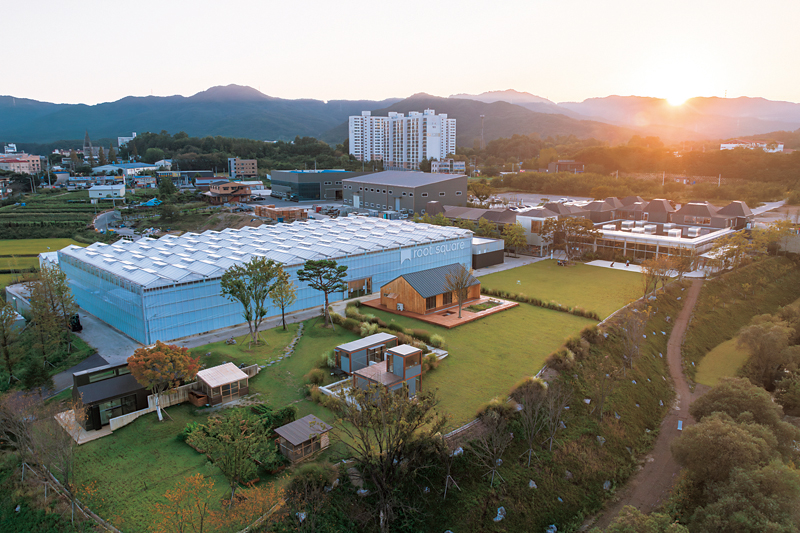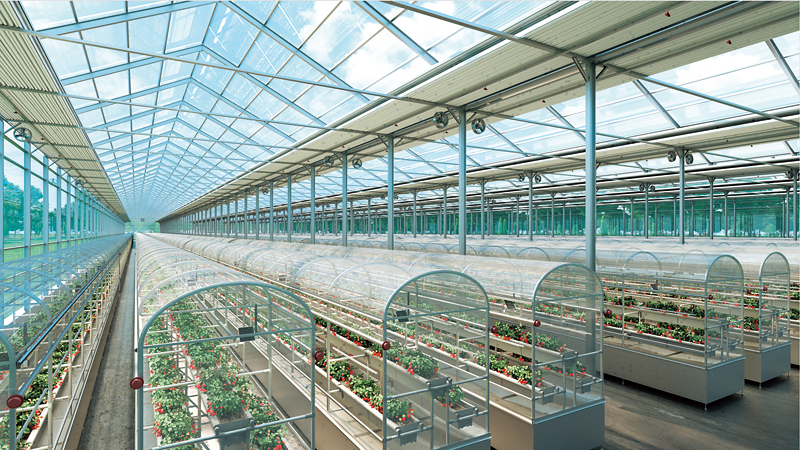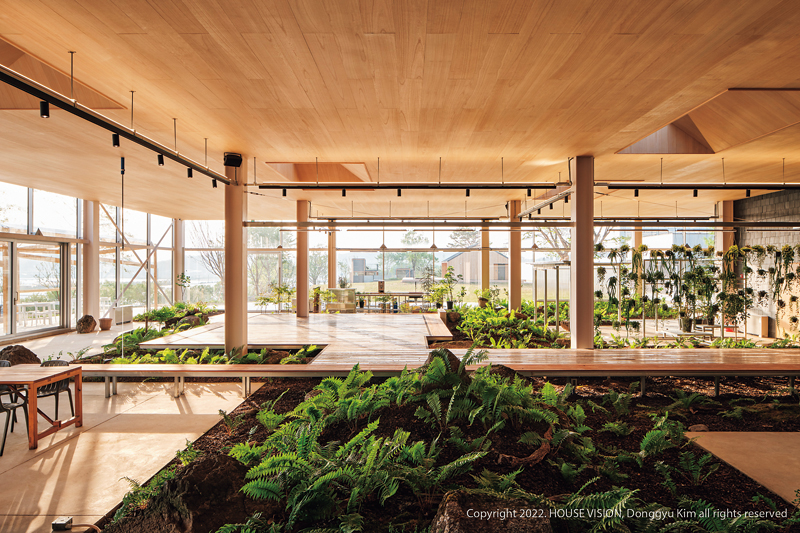Manna CEA leads the future of agriculture. Combining an environmental control system and aquaponics agriculture, the company’s technology offsets the uncertainties faced by conventional farming, including vulnerability to weather, and presents alternatives that address world food shortages caused by climate change.

Manna CEA’s futuristic complex in Jincheon implements the company’s environmental control system and aquaponics agriculture.
© MANNA CEA
The Ceo of Manna CEA, Jeon Tae-byeong, is a young farmer in his 30s who currently grows 40 different crops in Jincheon, a county in North Chungcheong Province. He doesn’t need to water or fertilize the crops himself because his control system manages them on its own while he is training aspiring farmers or giving interviews. Jeon is neither worried about water or labor shortages nor about rising fertilizer prices, because he is an engineer as much as a farmer.
TECHNOLOGY THAT BENEFITS THE WORLD
Before he started Manna CEA, Jeon had no farming experience. After majoring in mechanical engineering at KAIST, he was considering law school, when he happened to come across what is known as “appropriate technology.” This refers to technology that is developed with consideration for the political, cultural, and environmental aspects of the community where it will be used.
“When I heard about appropriate technology, I thought to myself that if I could combine my longstanding interest in agriculture with system control technology, which was my focus at university, I might be able to develop a technology that could benefit the world. I was constantly worried about the farming crisis, induced by climate change and the aging of the farming population. If the cultivating environment could be managed by a system, then the complex problems plaguing the agricultural community might be solvable.”
Jeon first established his company at KAIST’s Technology Business Incubation Center. He met with experts in organic farming and environmental control technology, among others, with the aim of developing a system capable of controlling agricultural environments. The system would use sensors to measure greenhouse temperature, humidity, light, and CO₂levels, as well as concentrations of the macro elements and micronutrients needed by plants. It would also collect and manage all of this information as digital data. Jeon believed that if he could succeed in developing such a system, it would be possible to implement the optimum growth environment anywhere in the world.
He also came up with his company’s name by combining Manna, the miraculous food sent from heaven in the Bible, and CEA, an acronym for “controlled environment agriculture.” This demonstrates Jeon’s desire that no one in the world go hungry and that this can be achieved by developing agricultural technology that provides food as if by divine intervention.
ECO–FRIENDLY AQUAPONICS SYSTEM
Developing the system was by no means easy. Keeping the organic matter supplied to crops at a constant concentration level was especially difficult. The use of chemical fertilizer would have made the job easier but went against Jeon’s ideal of technology that benefits the world. Then he came across aquaponics agriculture, an eco-friendly blend of aquaculture and hydroponics that allows both plants and fish to be farmed concurrently.
Aquaponics is a process of recycling water. Excrement from fish in tanks undergoes microbial fermentation and thus offers many of the nutrients required by plants. Once water supplied with these nutrients accumulates at the bottom of the farm, it goes through a purification filter and reenters the tank. In this way, the water necessary for growing the crops and raising fish is circulatedand reused.
Aquaponics agriculture has several advantages. First and foremost, it saves water. In conventional agriculture, the water used for crops is absorbed into the soil and cannot be reused. In an aquaponics system, on the other hand, the water used in crop cultivation and aquaculture can be circulated and reused permanently. Since Manna CEA began operating its farms in 2014, the efficiency of its water usage has been outstanding. Only water that evaporates naturally needs replenishing, which is why aquaponics agriculture, on average, requires just 5% of the water used by traditional farms.
The second advantage is the ability to farm organically. Conventional hydroponics uses chemical fertilizers to promote crop growth. However, Manna CEA doesn’t use any pesticides or synthetic materials, instead extracting nutrients for plants from fish excrement. In addition, while chemical residue in conventional hydroponics systems renders water difficult to reuse, in aquaponics systems, water can be monitored, purified, and reused, simply by regulating the concentration of organic matter. With a data-driven control system, a constant level of organic matter can be maintained

At Manna CEA, year-round production of strawberries is made possible by environmental controls and a data-driven, energy-efficient system.
© MANNA CEA
CONSUMERS AS FARMERS
As he was planning to implement environmental control and aquaponics systems on actual farms, Jeon heard that a greenhouse was up for sale in Jincheon. Although he had no ties to the community, he jumped at the opportunity to put into effect the technology that he believed could realize his dreams. When Manna CEA’s control system was first applied to the small scale greenhouse, it began yielding large quantities of agricultural produce.
“This is the third advantage of Manna CEA’s farming method,” Jeon explains. “Compared to traditional field cultivation, Manna CEA can harvest 120% more common crops and over 1500% more specialty crops. We are free from the risk of natural disasters and pests. By cultivating crops in a controlled environment using nutrient solutions, temperature and humidity control systems, and lighting systems, a consistent annual yield can be expected. What’s more, fish raised using aquaponics provide an additional source of income.”
Someone may ask how it is possible to sell such large quantities of produce. First, in order to provide fresh produce to consumers, Manna CEA operates experiential farms. Traditional farms require a lot of labor in the cultivation, harvesting, packaging, and sales processes. On the other hand, the experiential farms operated by Manna CEA allow children to pick and eat fresh strawberries themselves. This reduces the need for labor while also generating extra income through these paid experiences.
Second, the produce is also used for making salads that are then sold in ecofriendly packaging. Some ingredients are supplied to Root Square, a futuristic agricultural complex located in Jincheon, operated by Manna CEA. The complex connects farming with food service businesses such as cafés and restaurants and provides accommodation and agricultural education. Root Square and Manna CEA’s experiential farms average roughly 10,000 customers per month.
The buildings that make up Root Square, including the facilities for farm stays, were entries into the 2022 House Vision Korea Exhibition, an international architecture exhibition held in Jincheon. House Vision, initiated in 2011 by noted Japanese designer Kenya Hara, proposes future lifestyles and explores houses as platforms for new possibilities at the intersection of transportation, medicine, technology, and life. Under the theme of “Agriculture,” the House Vision exhibition in Jincheon was overseen by Hara himself and cohosted by Manna CEA. The future rural living platform can still be found at Root Square.

Root Square, a space where agriculture, technology, and culture come together, consists of an indoor garden, a café, an experiential farm, a smart farm, accommodation for farm stays, and areas providing a glimpse into the future of rural villages.
© Kim Dong-gyu
AGRICULTURE AND ENGINEERING
Jeon defines Manna CEA as “a company that sells agriculture related facilities and auxiliary software to farmers.” He hopes that Root Square will be a place where people discover the future potential of rural areas.
“Some people want to take up farming but hesitate because they lack experience or see no way to solve problems of labor or capital. Environmental control systems can help overcome the issues of experience and labor. If it’s difficult to develop sales channels, then you can attract people to the farm. If there’s no capital, you can recruit people who want to participate in agriculture as investors and operate farms together, sharing profits. By changing your mindset, you can find possibilities in rural areas where others see problems.”
The wider world is now investing in Manna CEA’s future-oriented technology, which is currently being exported to countries such as Kazakhstan, Saudi Arabia, and the United Arab Emirates. Manna CEA has also become the first Asian company to receive organic certification from the United States Department of Agriculture. Construction on its first plant factory has been completed in Saudi Arabia, and additional orders are on the horizon. However, Jeon’s aspirations are even higher.
“My goal is to make Manna CEA the best ‘solution company’ and establish agriculture as an environmentally friendly engineering industry. To achieve this, I will continue to develop solutions to rural problem
Since the agricultural revolution began 6,000 years ago, humans have sustained themselves through farming. Now, Manna CEA aims to start a green revolution where every person in the world can live without worrying about food.